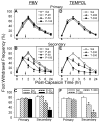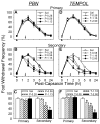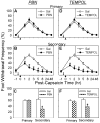Oxidative stress in the spinal cord is an important contributor in capsaicin-induced mechanical secondary hyperalgesia in mice
- PMID: 18375065
- PMCID: PMC2581506
- DOI: 10.1016/j.pain.2008.01.029
Oxidative stress in the spinal cord is an important contributor in capsaicin-induced mechanical secondary hyperalgesia in mice
Abstract
Recent studies indicate that reactive oxygen species (ROS) are critically involved in persistent pain primarily through spinal mechanisms, thus suggesting ROS involvement in central sensitization. To investigate ROS involvement in central sensitization, the effects of ROS scavengers and donors on pain behaviors were examined in mice. Capsaicin- induced hyperalgesia was used as a pain model since it has 2 distinctive pain components, primary and secondary hyperalgesia representing peripheral and central sensitization, respectively. Capsaicin (25 microg/5 microl) was injected intradermally into the left hind foot. Foot withdrawal frequencies in response to von Frey filament stimuli were measured and used as an indicator of mechanical hyperalgesia. The production of ROS was examined by using a ROS sensitive dye, MitoSox. Mice developed primary and secondary mechanical hyperalgesia after capsaicin injection. A systemic or intrathecal post-treatment with either phenyl-N-tert-butylnitrone (PBN) or 4-hydroxy-2,2,6,6-tetramethylpiperidine-1 oxyl (TEMPOL), ROS scavengers, significantly reduced secondary hyperalgesia, but not primary hyperalgesia, in a dose-dependent manner. Pretreatment with ROS scavengers also significantly reduced the magnitude and duration of capsaicin-induced secondary hyperalgesia. On the other hand, intrathecal injection of tert-butylhydroperoxide (t-BOOH, 5 microl), a ROS donor, produced a transient hyperalgesia in a dose-dependent manner. The number of MitoSox positive dorsal horn neurons was increased significantly after capsaicin treatment. This study suggests that ROS mediates the development and maintenance of capsaicin-induced hyperalgesia in mice, mainly through central sensitization and that the elevation of spinal ROS is most likely due to increased production of mitochondrial superoxides in the dorsal horn neurons.
Figures








References
-
- Abe K, Saito H. Characterization of t-butyl hydroperoxide toxicity in cultured rat cortical neurones and astrocytes. Pharmacol Toxicol. 1998;83:40–46. - PubMed
-
- Baumann TK, Simone DA, Shain CN, LaMotte RH. Neurogenic hyperalgesia: The search for the primary cutaneous afferent fibers that contribute to capsaicin-induced pain and hyperalgesia. J Neurophysiol. 1991;66:212–227. - PubMed
-
- Coderre TJ, Xanthos DN, Francis L, Bennett GJ. Chronic post-ischemia pain (CPIP): a novel animal model of complex regional pain syndrome-Type I (CRPS-I; reflex sympathetic dystrophy) produced by prolonged hind paw ischemia and reperfusion in the rat. Pain. 2004;112:94–105. - PubMed
Publication types
MeSH terms
Substances
Grants and funding
LinkOut - more resources
Full Text Sources
Other Literature Sources

